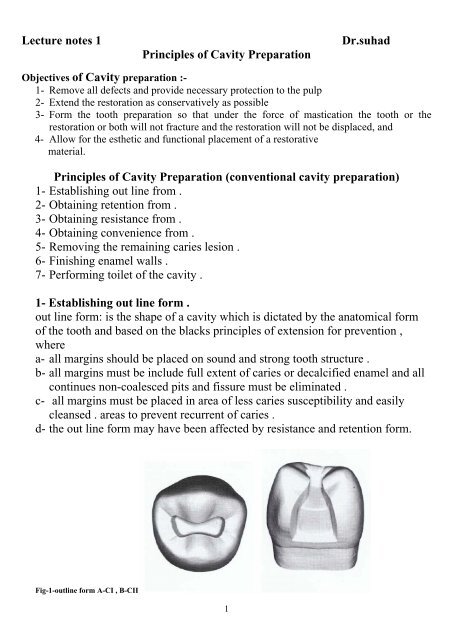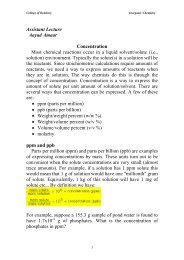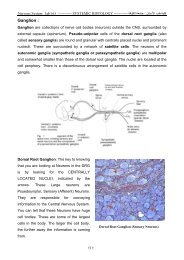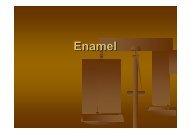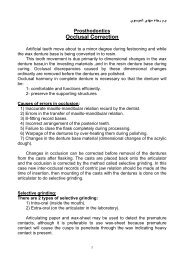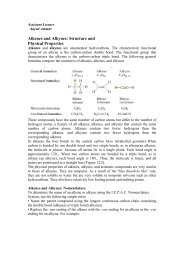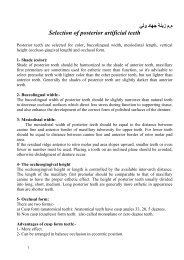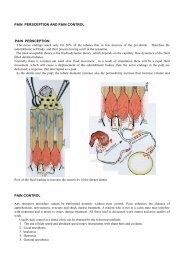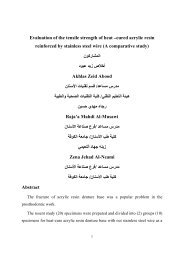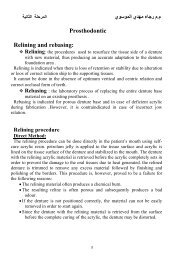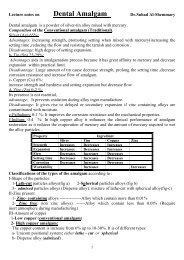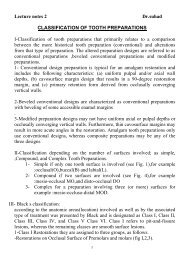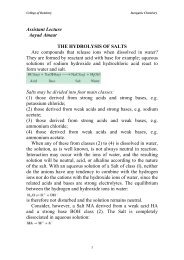Lecture notes 1 Dr.suhad Principles of Cavity Preparation Principles ...
Lecture notes 1 Dr.suhad Principles of Cavity Preparation Principles ...
Lecture notes 1 Dr.suhad Principles of Cavity Preparation Principles ...
Create successful ePaper yourself
Turn your PDF publications into a flip-book with our unique Google optimized e-Paper software.
<strong>Lecture</strong> <strong>notes</strong> 1<br />
<strong>Principles</strong> <strong>of</strong> <strong>Cavity</strong> <strong>Preparation</strong><br />
<strong>Dr</strong>.<strong>suhad</strong><br />
Objectives <strong>of</strong> <strong>Cavity</strong> preparation :-<br />
1- Remove all defects and provide necessary protection to the pulp<br />
2- Extend the restoration as conservatively as possible<br />
3- Form the tooth preparation so that under the force <strong>of</strong> mastication the tooth or the<br />
restoration or both will not fracture and the restoration will not be displaced, and<br />
4- Allow for the esthetic and functional placement <strong>of</strong> a restorative<br />
material.<br />
<strong>Principles</strong> <strong>of</strong> <strong>Cavity</strong> <strong>Preparation</strong> (conventional cavity preparation)<br />
1- Establishing out line from .<br />
2- Obtaining retention from .<br />
3- Obtaining resistance from .<br />
4- Obtaining convenience from .<br />
5- Removing the remaining caries lesion .<br />
6- Finishing enamel walls .<br />
7- Performing toilet <strong>of</strong> the cavity .<br />
1- Establishing out line form .<br />
out line form: is the shape <strong>of</strong> a cavity which is dictated by the anatomical form<br />
<strong>of</strong> the tooth and based on the blacks principles <strong>of</strong> extension for prevention ,<br />
where<br />
a- all margins should be placed on sound and strong tooth structure .<br />
b- all margins must be include full extent <strong>of</strong> caries or decalcified enamel and all<br />
continues non-coalesced pits and fissure must be eliminated .<br />
c- all margins must be placed in area <strong>of</strong> less caries susceptibility and easily<br />
cleansed . areas to prevent recurrent <strong>of</strong> caries .<br />
d- the out line form may have been affected by resistance and retention form.<br />
Fig-1-outline form A-CI , B-CII<br />
1
2- Retention from .<br />
That shape <strong>of</strong> a cavity which is prevents the displacement <strong>of</strong> the restoration .<br />
Basically this obtained by :<br />
a- the walls <strong>of</strong> cavity should be parallel or converge occlusally (5 O ) .<br />
b- the floor <strong>of</strong> the cavity should be flat .<br />
c- the smaller out line form the less displacing force on it .<br />
There are several other methods <strong>of</strong> obtaining retention for restoration such as :<br />
dovetails , pits , grooves and pin .<br />
FIG - 2 - Retention form :- Flat floor (A) will help prevent restoration movement, whereas rounded pulpal floor ( B) may<br />
allow a rocking action <strong>of</strong> restoration and also producing a wedging force, which may result in shearing <strong>of</strong> tooth<br />
structure;(affecting resistant <strong>of</strong> tooth to fracture).<br />
3-Resistance from .<br />
A from <strong>of</strong> cavity that prevents fracture <strong>of</strong> both tooth and restoration .<br />
I- Prevention <strong>of</strong> tooth fracture :-<br />
a- width <strong>of</strong> the cavity not more than 1/4 <strong>of</strong> the inter cuspal distance (prevent<br />
cusp fracture).<br />
b- removal <strong>of</strong> unsupported enamel ,a weak portion <strong>of</strong> the tooth should be<br />
removed and replaced by a restorative material .<br />
c- flat pulpal floor .<br />
d- rounded internal line angles .<br />
e- M and D cavity walls must be parallel or diverge occlusally .<br />
f- beveling <strong>of</strong> gingival cavo surface line angle in class II.(CII)<br />
II - Prevention <strong>of</strong> restoration fracture :-<br />
a- reduce the surface area <strong>of</strong> the restoration . the width <strong>of</strong> the cavity done about<br />
1/4 intercuspal distance . the amalgam is brittle and if there is more surface<br />
area there will be more force and this will lead to fracture <strong>of</strong> the amalgam .<br />
b- flat pulpal floor .<br />
c- beveling <strong>of</strong> the axiopulpal line ingle in cII . so the stress will be diffuse .<br />
d- isthmus us area is 1/4 inter cuspal distance in cII .<br />
2
e- the restoration must be <strong>of</strong> adequate thickness, this by Increasing the depth <strong>of</strong><br />
the cavity so increasing the amalgam thickness because it is brittle material<br />
(amalgam thickness should be at least 1.5mm and preferably 2mm) .<br />
f- the restoration must be <strong>of</strong> a marginal design that will allow it to bear the force<br />
<strong>of</strong> mastication without fracture or deformation <strong>of</strong> the restoration so the<br />
Cavosurface line angle should be as near to right angle 90 o -110 o . (Fig3-A)<br />
- if the angle less than 90 o -110 o it make unsupported enamel . (Fig3-B)<br />
- if the angle greater than 110 o it makes thin amalgam margin which leads<br />
to fracture <strong>of</strong> the amalgam at that margin .(Fig3-C)<br />
A B C<br />
Fig 3<br />
4- Convenience form :-<br />
That shape <strong>of</strong> cavity that allows adequate observation , access ability and ease <strong>of</strong><br />
operation in preparing and restoring the cavity . so we may do widening to<br />
improve the accessibility and usage <strong>of</strong> the instruments .<br />
5- Removal <strong>of</strong> caries :-<br />
If caries is minimal , caries is removed during step <strong>of</strong> cavity preparation , if deep<br />
, we remove the carious lesion by large round bur rotating at low speed . ,the<br />
walls must be tendered caries free .<br />
6- Finishing <strong>of</strong> enamel walls .<br />
It has been shown that better marginal adaptation is obtainable when the enamel<br />
is smooth and all week fragmented prisms have been removed so we get :-<br />
1- best marginal seal 2- maximal strength <strong>of</strong> both enamel and restoration .<br />
7- Toilet <strong>of</strong> cavity :<br />
All debris and particles have been washed away , the cavity is dried with cotton<br />
wool and thus is ready to be restored .<br />
3
This document was created with Win2PDF available at http://www.win2pdf.com.<br />
The unregistered version <strong>of</strong> Win2PDF is for evaluation or non-commercial use only.<br />
This page will not be added after purchasing Win2PDF.


